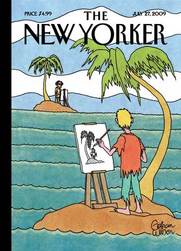Emdashes—Modern Times Between the Lines
The Basics:
About Emdashes | Email us
Ask the Librarians
Best of Emdashes: Hit Parade
A Web Comic: The Wavy Rule
Features & Columns:
Headline Shooter
On the Spot
Looked Into
Sempé Fi: Cover Art
Sempé Fi (On Covers): The Island
Filed under: Sempé Fi Tagged: art, covers, Gahan Wilson, islands, Pollux, Robinson Crusoe

Pollux writes:
I drew a joke about desert island jokes a few weeks ago. It struck me, as I’m sure it has struck many observers, that the desert island features often as a comic device, especially within the pages of The New Yorker.
And now it appears on the cover of the July 27, 2009 issue. Gahan Wilson’s cover is of course a comment also on the desert island as a frequent location in one panel gags and cartoons. Last year, Mike Lynch’s cartoon blog voted for the desert island number one for gag cartoon clichés (second place was the Psychiatrist’s Couch, while third was The Grim Reaper).
Wilson’s cover, called “Cartoon Island,” of course features two cartoon islands, occupied by two artists drawing inspiration from one another across the treacherous-looking channel that separates them. The canvas we are allowed to see features a third island, occupied by a smiling castaway.
The castaway featured in the canvas is not a portrait of the bespectacled artist farthest away from us. The bespectacled artist simply provided the initial inspiration. The blond artist whose back is to us sees inspiration across the channel but not an opportunity for exact portraiture.
He is of course a castaway himself, but neither artist may realize this. So they paint and draw, sustaining themselves on Art and the off-chance that 7.5 oz cans of beans and franks and some desalinization equipment will wash up on their picayune shores.
Wilson has thus turned the desert island device on its own head. As Wilson has remarked, “the creative artist is automatically an outsider, because he sees through the world that everybody else takes as the final reality, and he’s a very scary kind of guy.” Instead of a subject of art the island has become a place for producing art. The cartoon desert island is producing art about cartoon desert islands.
These cartoon desert islands usually look the same: they’re about the size of a Smart Car, usually sustaining a single palm tree and a single inhabitant, who is usually male. He wears the costume of a comic castaway: frayed slacks and shirt. He is sometimes unshaven, and always uninjured, and mysteriously does not look very undernourished. This is a humorous cartoon after all.
These desert islands are usually covered by a soft carpet of sand instead of unfriendly coral as sharp as an X-acto knife. Their very stripped-down quality makes desert islands a good location for humor. All you have is a man, an island, and the possiblity of a punchline. The cartoonist introduces some element that disrupts this minimalist world, and makes a comment on the world at large. The island is a laboratory for exploring ourselves.
The islands are ridiculously small, but their size allows us to see an entire world at once, a society in miniature, and of course, a small island is better than the dangers of the sea. As Gonzalo, the honest old counselor in Shakespeare’s “The Tempest,” declares, “Now would I give a thousand furlongs of sea for an acre / of barren ground—long heath, brown furze, anything.”
Wilson’s art, produced over the course of half a century, is sometimes described as scary or creepy, but here acquires a certain satirical tinge that is not particularly disturbing or sinister. His “Cartoon Island” is considerably less sinister than another of his cartoon islands, which is not an island at all but a large sea monster -which is itself an old literary theme.
Wilson’s Cartoon Archipelago, composed of ink and watercolors, is a place of industry and stimulation. “I began to conclude in my mind,” Robinson Crusoe realizes on his deserted island, “that it was possible for me to be more happy in this forsaken, solitary condition than it was probable I should ever have been in any other particular state in the world.”
On Wilson’s “Cartoon Island,” we find two artists finding inspiration in the bleakest of circumstances, and thus finding a form of happiness through their art despite the fact that only the smallest of patches of earth separates them from a deep and hazardous ocean. The ocean is Neptune’s domain; skillful cartooning is Wilson’s.




